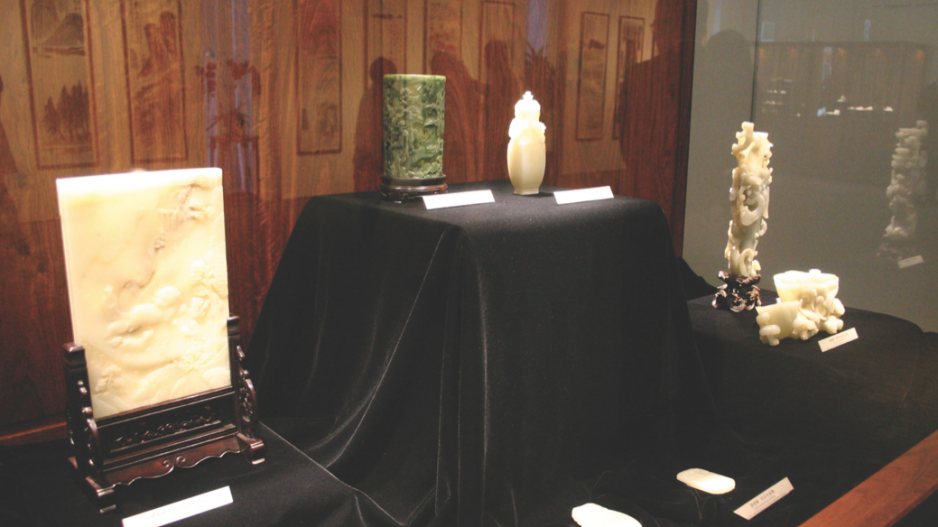With the region’s large population of wealthy overseas Chinese, Metro Vancouver has long been a popular location for auctioneers of Asian art to find collectors willing to sell their private items to the now-sizable base of buyers in China.
But – as the latest exhibition at Vancouver’s Poly Culture Art Center demonstrates – industry officials are now trying to develop the reverse side of that business by making entry forays into the Lower Mainland, testing whether the region’s high-income consumers (Chinese or otherwise) can become a new market for making Chinese art purchases.
The exhibit, which kicked off October 4, is a double feature of two “heavyweight” staples in the Chinese art collectors’ industry. It is headlined by 67 pieces of historic jade art pieces, dating back as far as the Song Dynasty of China 1,000 years ago. These jade pieces are, in turn, accompanied by replicas of several highly sought-after paintings – including one by Qi Baishi, one of China’s most famous painters in the last century.
What’s unconventional about this particular exhibit, however, is that it is among the first in Vancouver to also double as a sales showroom of sorts; the jade items, which come from a Chinese collector, are all for sale. The original paintings on which the replicas shown in Vancouver are based are also slated for auction in China later this year.
“The key is to develop the mainstream public’s appreciation of these art pieces,” said Chen Lianyong, president of Spring Art Investment Management Ltd. in Beijing, which owns the jade artifacts. “Because if you don’t like it, you won’t buy it no matter how much information we give you. If you like it, you will usually buy – with or without the information. It takes time to develop that appreciation, and this is the first step.”
Chen added that the majority of the jade pieces are animal statuettes, an intentional choice because he believes the subject matter is easily appreciated by people – and, potentially, buyers – of all backgrounds. Most items have sale prices “in the five figures,” although a few of the larger pieces are selling for “six figures in Canadian dollars,” he added.
“Because of the cost of storage, insurance and other exhibit-related expenses, we are basically selling each item at the price we bought [it] at auction for, plus 40%,” Chen said. “I think the challenge here, for potential western buyers, will be cost. If you don’t understand the history and cultural appreciation of jade artifacts in China, you will find the prices a bit expensive. But this is only a start in helping people here to have some exposure to jade art.”
The Chinese art market globally has skyrocketed in the last 15 years as the growing Chinese economy provided more buyers with the resources to purchase art. In 2011, total global sales reached close to US$12 billion, and data shows sales in China grew by 7% last year to US$4.8 billion, according to industry publication Artnet.
But analysts have also noticed a recent weakening of the market, with total global sales breaching US$8 billion only once since 2011 and hovering around US$7 billion in the last two years.
Last year, Asia accounted for 78.6% of sales; North America accounted for 13.2%. And while Chinese art sales in China are growing, Artnet also reported that non-payment remains a big problem there, with only 51% of Chinese buyers at auctions paying for the items they’ve promised to purchase.
All of these factors may indicate why North America – and, more specifically, Vancouver – is now being viewed not only as a market to acquire Chinese art, but also as a potentially attractive and more reliable market of buyers.
Poly Culture North America, which began operating in Vancouver almost three years ago, is one of the largest companies attracted by HQ Vancouver to set up regional headquarters in B.C. The art centre – touted as a key cornerstone of Poly Culture’s attempt to expand its art, theatre management and cultural promotion businesses in the West – opened last November.
Company CEO Chen Yi said the company wanted to bring something iconically Chinese to the exhibit space this year to help celebrate Canada 150, and the jade and painting double exhibit is part of that effort.
She added that everything the company is doing – including being a main sponsor to this summer’s Monet exhibit at the Vancouver Art Gallery – is to show the company’s role as an active member of Vancouver’s local art and business community.
Chen said that she understands the public scrutiny on the company’s corporate structure (China Poly Group, Poly Culture’s parent company, is a Chinese state-owned enterprise with marked links to the country’s military and defence industry) in Canada’s public discourse but added that she hopes people take Poly Culture’s work in Vancouver at face value.
“Canada is a democratic country where people have the right to express how they feel, so I understand there are misunderstandings,” Chen said. “Exhibits like this one is a good opportunity for people to know who we are.… Our 14 employees in Vancouver are all Canadian citizens; and on the transparency issue, Poly Culture Group [HKG:3636] is a publicly traded company in Hong Kong. Therefore, we have to be transparent, because we have a responsibility to answer to our shareholders.”
She added that Poly is now looking to Canadian groups like the Vancouver Symphony Orchestra – with which Poly has a working relationship – as well as Aboriginal artists and others to bring potential performances and exhibits to China. Chen said other sponsorships of non- Chinese art events like the Monet exhibit are also a possibility. •




